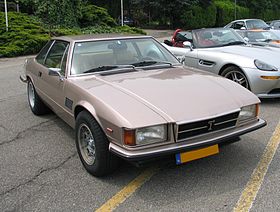De Tomaso Longchamp
| De Tomaso Longchamp | |
|---|---|
 |
|
| Overview | |
| Manufacturer | De Tomaso |
| Production | 1972–1989 |
| Designer | Tom Tjaarda under Ghia |
| Body and chassis | |
| Class | Grand tourer |
| Body style | 2-door coupé 2-door convertible |
| Layout | FR layout |
| Related | Maserati Kyalami |
| Powertrain | |
| Engine | 5.8L V8 (Ford) |
| Transmission | 3-speed automatic 5-speed manual |
| Dimensions | |
| Wheelbase | 2600 mm (102.4 in.) |
| Length | 4600 mm (181.1 in.) |
| Width | 1830 mm (72 in.) |
| Height | 1295 mm (51 in.) |
| Curb weight | 1815 kg (4001 lb) (GTS) |
The De Tomaso Longchamp is an automobile which was produced by the Italian automaker De Tomaso from 1972 to 1989.
The Longchamp was developed from the De Tomaso Deauville four-door sedan, using a shorter wheelbase chassis with the same suspension, engine and transmission. The two models were the only front-engined production cars produced by De Tomaso. The Longchamp was first exhibited at the 1972 Turin Motor Show and was initially offered only as a two-door 2+2 coupé. It was designed by Tom Tjaarda of Ghia and was influenced by his previous Lancia Marica prototype. The taillights were the same units as were used for the Alfa Romeo 1750/2000 saloon. The headlights and front indicators are from Ford of Europe Models Ford Consul / Granada. The name Longchamp is likely a reference to the Longchamp Racecourse in Paris and/or Longchamps, a city near de Tomaso company founder Alejandro de Tomaso's Buenos Aires birthplace.
The Longchamp featured a long and wide hood to accommodate the American power train, i.e. the 351 cubic inch (5,769 cc) Ford Cleveland V8. The 351 Cleveland, a popular and very potent engine in early 1970s Ford "muscle cars," was the same unit as that used in the Pantera. It produced a minimum of 330 hp (246 kW) and gave the Longchamp an official 240 km/h (149 mph) top speed. The standard gearbox was a three-speed Ford C-6 Cruise-o-Matic automatic gearbox, however around 17 cars were equipped with a five-speed ZF manual gearbox. The suspension was independent front and rear with coil spring and wishbone suspension. Steering was power assisted rack and pinion with vented disc brakes all around, the rear discs being positioned inboard. The interior of the car was quite luxurious and it was almost fully covered with leather, although the use of Ford's partsbin (steering wheel, gear shift) took away somewhat of the luxurious impression.
...
Wikipedia
